
views
Writing Employee Feedback in an Email

Acknowledge your reason for sending the email. You can do this in the subject line or inside the email. It’s often best to let the person know in the subject line so that they know what to expect from the email. Make the subject, “Project Proposal Feedback - Great Start!”

Open with a friendly remark. This will show the person that you are giving the feedback in a friendly rather than a critical tone. It will increase the likelihood that the receiver reads your words as constructive. Write a phrase like, “I hope you’re having a great week!”
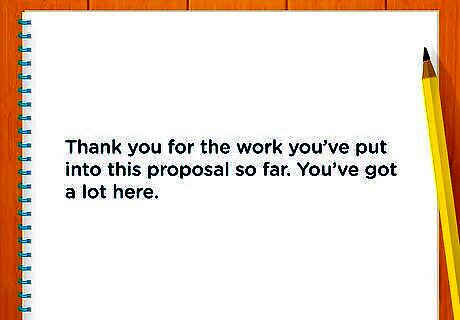
Acknowledge the work that the person has done. Chances are, the person who is receiving the feedback has already put a lot of work into what you're evaluating. Mention this up front, letting them know that you recognize their efforts. You could say something like, “Thank you for the work you’ve put into this proposal so far. You’ve got a lot here.”

Give positive feedback first. Telling the person what they are doing right first will soften the upcoming criticism. Be honest, but try to find something positive. You could focus either on the current task or on past work efforts. Say, “This is another strong proposal. You’ve put together a terrific set of objectives, and I can see a lot of development in your methodology.”
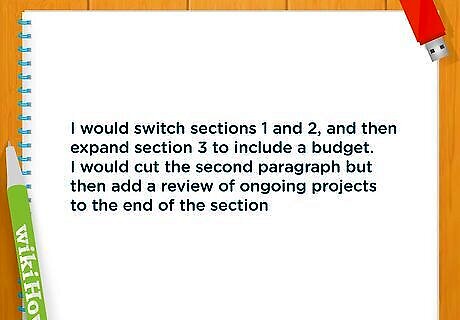
Phrase negative feedback as advice. While it can be more efficient to list necessary changes, this can be difficult for the receiver to read and can make them feel discouraged. Instead, frame it as the changes you would make. You could write, “I would switch sections 1 and 2, and then expand section 3 to include a budget,” or “I would cut the second paragraph but then add a review of ongoing projects to the end of the section.”

Explain your negative feedback. Tell the person where they are having issues, clarifying why it’s a problem when necessary. If the criticism is due to a change in expectations or direction, tell them this, detailing why the change was made. Say something like, “We’re making a company-wide shift to more detailed proposals, so we’ll need to see some expansion in a few sections. I’ve outlined where we need more information.” If your feedback concerns behaviors that the person is doing, always provide examples of what you mean. For example, if you are addressing unprofessional dress at client meetings, then you should give examples of what they have done wrong. You could say, "Last time we met with the client, you wore flip-flops, and the time before you wore a t-shirt. This type of casual dress doesn't convey the professional image we want to represent our company."
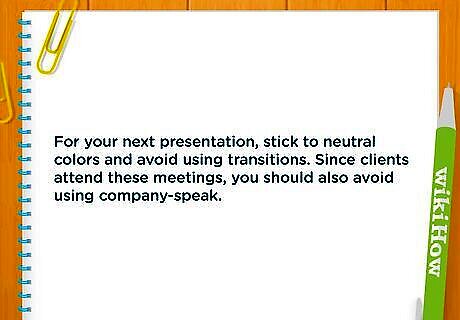
Specify how they can fix the issues. Your feedback will likely not be helpful without ways they can fix the issues. Depending on the subject of the feedback, this could be anything from a list of specific fixes to a general checklist of things to target. You could provide examples of ways that they can fix the issues. This is a great option for when you have a specific fix in mind. You could say, "For your next presentation, stick to neutral colors and avoid using transitions. Since clients attend these meetings, you should also avoid using company-speak." Alternatively, you could ask them questions that will help them think of ways to fix them. This option is a great way to address issues that could have multiple acceptable solutions. For example, “What are some ways that you could improve documentation moving forward?" or “What changes do you plan to implement in your next presentation?”
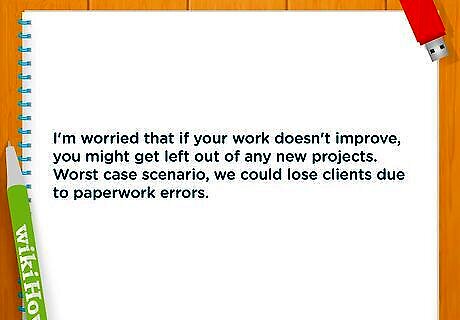
Remind them of any consequences that can occur. Some work issues can harm the organization, and the employee should be told this. Many times there are few consequences, but sometimes you may lose clients or provide less effective customer service due to the employee’s shortcomings. Depending on the situation, there may also be consequences for the employee if changes aren't made. If there are issues, let the employee know. For example, tell them about concerns that your business could lose clients due to paperwork errors. Alternatively, let them know if they could be left off a new project if they don’t improve their documentation efforts.
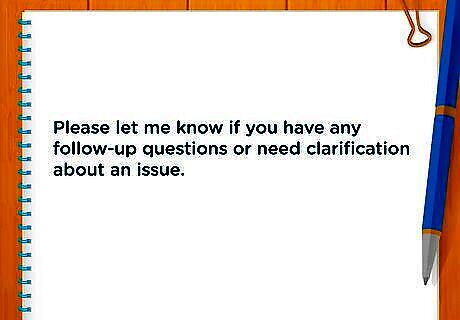
End with an offer to clarify and explain your feedback. This is a friendly way to end your email that lets the person know that you are in their corner. Additionally, it will make them feel comfortable asking for clarification if you presented something in a way they didn’t understand. Write a phrase like, “Please let me know if you have any follow-up questions or need clarification about an issue.”
Writing Feedback in a Performance Review

Set an objective for the performance review. This is why you are doing the evaluation. Knowing your objective can help you better formulate feedback and will help your employee know what to expect. For example, are you focusing on employee improvement? Are you doing a company-wide assessment to determine what kind of professional development your company would benefit from most? Are you performing a quarterly review? Tell the employee the objective when you provide them with the feedback. You could say, "The company plans to offer professional development sessions based on employee needs, so I'm conducting performance reviews for each employee."

Review feedback they were previously given. This could include feedback from a prior review, as well as informal feedback given throughout the evaluation period. You should also assess what they have done with that feedback. Have they used it to improve? Did it not get addressed? If they acted on past feedback, then this could be included as a positive in this review. If they didn’t address past feedback, you can discuss both the original issue and the lack of initiative in not addressing the feedback.
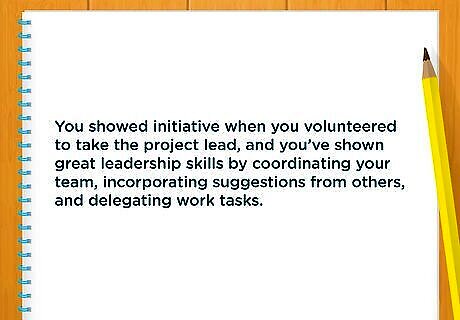
Explain the positive feedback, giving specific examples. It’s always best to start with the good comments. Tell the employee what they’ve been doing right, specifying any achievements they have had. Be honest, but try to include as many positive things as you will negative. Give examples, such as “You showed initiative when you volunteered to take the project lead, and you’ve shown great leadership skills by coordinating your team, incorporating suggestions from others, and delegating work tasks.” Praise behavior that you want to see continued.
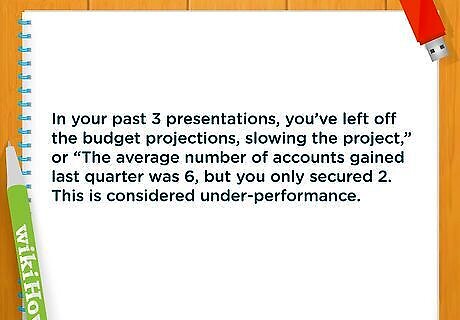
Give constructive criticism, providing specific examples. Focus your criticism on what can most benefit your organization or the employee’s work goals. Tell them what you have seen them struggling with, and why it’s an issue. Make your examples specific. For example, “In your past 3 presentations, you’ve left off the budget projections, slowing the project,” or “The average number of accounts gained last quarter was 6, but you only secured 2. This is considered under-performance.”

Set performance objectives for the next evaluation period. This will help your employee know what they should focus on moving forward, allowing you to get what your organization needs out of the employee. It will also make the feedback more useful to the employee because they know what you want them to take away from the evaluation. Objectives should be short and specific. For example, "Employee will average 4 sales per day," "Employee will increase communication with clients," or "Employee will complete leadership training." Make sure that the next evaluation that you do for this employee focuses on these performance objectives, since that is what your employee will expect.
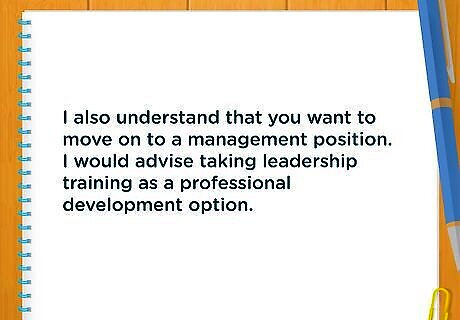
Suggest professional development opportunities. Base your recommendations on the constructive criticism you have provided. Depending on your resources, this could include workshops, training courses, in-house training, or mentorships. You may even want to look for free courses online if resources are low. Be open to changing these suggestions after you discuss the review with the employee. For example, your employee may request professional development that you hadn't considered. You should also consider the employment goals of your employee. For example, if your employee wants to move to a management position, you might choose leadership training as a professional development option. Alternatively, if your employee is interested in graphic design, you may allow them to attend training courses so that they can use those skills for your organization.

End with a piece of encouragement. No matter how glowing the performance review is, no one likes to be told about their shortcomings or what they need to do to improve. Ending with a piece of encouragement can help the employee leave feeling empowered rather than overwhelmed or discouraged. Say something like, “Last quarter had some unexpected hiccups, but you’ve done a great job adjusting your workload. We like what we’ve been seeing and hope to see more good stuff this quarter.”
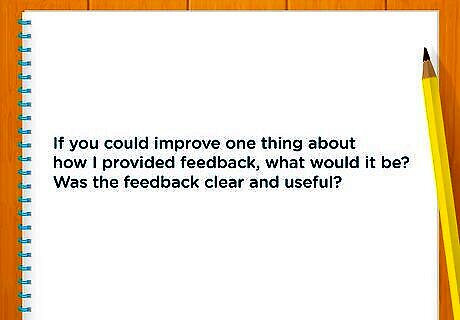
Encourage a response from the receiver. This could be a verbal response after you discuss the review with them, or you could give them a feedback form to complete. You will receive a better response if you allow the employee to think about the performance review and compose feedback without you present. Ask the person to offer their own feedback on the feedback you provided. For example, “If you could improve one thing about how I provided feedback, what would it be?" and “Was the feedback clear and useful?”
Giving Feedback to a Student

Keep the focus on student learning. The purpose of feedback is to help students learn, so give useful comments that direct them toward improving their work rather than chastising mistakes. Treat it as instruction and not just a critique. You may provide written feedback on different types of student assignments, including written assignments, presentations, and projects.
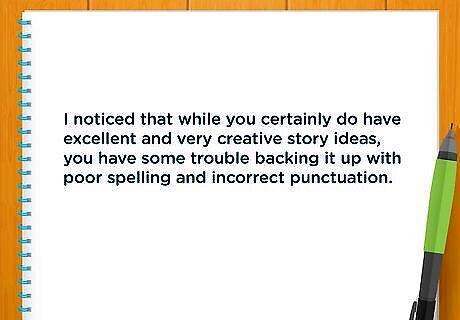
Provide feedback on both content and mechanics. They are both important, and students need to know how to improve in both areas. This is especially important if a student is stronger in one area than another. For example, a student may have excellent ideas with good development, while also having poor spelling, incorrect punctuation, and excessive fragments and run-ons. If you are giving the feedback on an oral presentation or project, be sure to provide feedback on each part of the assignment. For example, an oral presentation would include feedback on both content and public speaking skills, while a project may receive feedback on content, creativity, and execution.
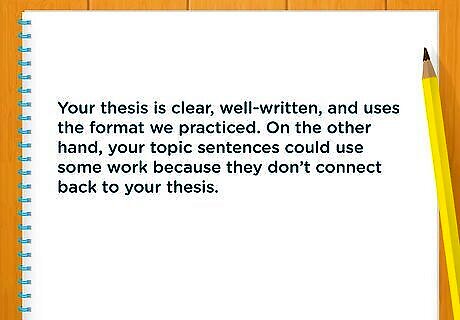
Be specific about both positive and negative feedback. Writing comments like “good job,” “very improved,” or “this needs work” doesn't tell the student what they need to do to improve or what they’re doing right. In order for the feedback to be effective, the student needs to know what you saw that either worked or didn’t. Write something like, “Your thesis is clear, well-written, and uses the format we practiced. On the other hand, your topic sentences could use some work because they don’t connect back to your thesis.” Suggest, “Your ideas are well-developed, but I’d recommend you come to tutoring so that we can work on your comma splices and sentence fragments.” Include a mix of positive comments and constructive criticism.
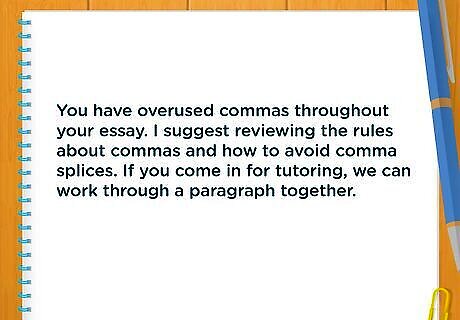
Suggest ways to make improvements rather than correcting mistakes. You may mark some errors, but avoid copyediting the paper. State the issue that you’ve seen in the paper, such as overuse of commas, and then suggest the skill the student can work on. For example, “You have overused commas throughout your essay. I suggest reviewing the rules about commas and how to avoid comma splices. If you come in for tutoring, we can work through a paragraph together.
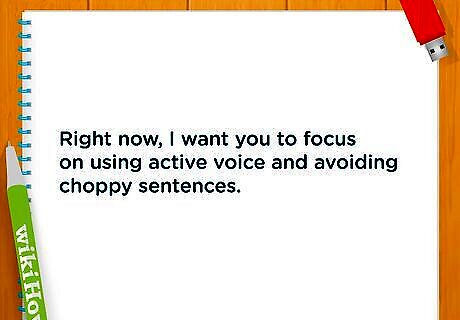
Set priorities for the next draft or assignment. This will give the student something to focus on moving forward. You can base the priorities on the learning objectives or student needs, depending on that student’s work. Say, “Right now, I want you to focus on using active voice and avoiding choppy sentences.”

Limit your feedback to one section or skill if time is an issue. Focus your attention on either the current learning objectives or the needs of the student you are assessing. Make sure that your students know that you are only evaluating limited parts of their writing so that they don’t assume other sections are perfect. You may want to highlight or mark the section where you are providing feedback. Before giving the students their assignments back, let them know that you only provided feedback on part of the assignment. You could also allow students to choose which skill or section they want feedback on.

Avoid overwhelming the student. If there are many errors, don’t try to fix them all in one feedback opportunity. Providing too much at one time can feel overwhelming to the student, causing them to become discouraged. Instead, start with the foundational corrections or the easiest tweaks. For example, you could begin by focusing on avoiding sentence fragments and looking up words you don’t know how to spell. You could also focus on just the learning objective that the assignment is addressing.

Motivate your student to keep working. End on a positive note, encouraging them to keep working. You may want to reference other improvements you have seen in their work, empowering them to aim higher. Write something like, “After seeing how well your writing has developed this year, I know you will do a terrific job with these suggestions. I look forward to reading your next essay!”


















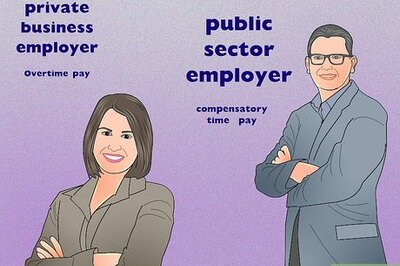

Comments
0 comment